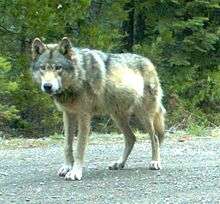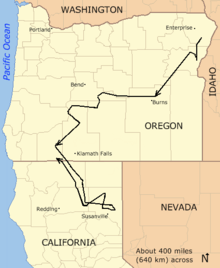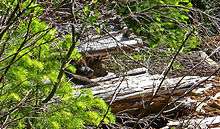OR-7
OR-7, also known as Journey, is a male gray wolf that was electronically tracked as he migrated from the Wallowa Mountains in northeastern corner of the U.S. state of Oregon to the southern Cascade Range. After the wolf left his pack in 2011, he wandered generally southwest for more than 1,000 miles (1,600 km) through Oregon and northern California. He was the first confirmed wild wolf in western Oregon since 1947 and the first in California since 1924.
 OR-7 in Jackson County, Oregon, in May 2014 | |
| Other name(s) | Journey |
|---|---|
| Species | Canis lupus |
| Breed | Canis lupus occidentalis |
| Sex | Male |
| Born | April 2009 Oregon |
| Nation from | United States |
| Parent(s) | B-300 (mother)[1] |
| Offspring | 7 pups[2] |
| Weight | 90 lb (41 kg) in February 2011[3] |
| Appearance | Gray |
| Named after | 7th wolf collared in Oregon |
By 2014, OR-7 had settled in the Rogue River watershed in the southern Cascade Range east of Medford, Oregon, with a mate. It is not known when the two wolves met, but DNA tests of fecal samples showed that she is related to wolves in two of the eight packs in northeastern Oregon. In early 2015, officials designated the two adult wolves and their offspring as the Rogue Pack, the first wolf pack in western Oregon and the state's ninth overall since wolves returned to Oregon from Idaho in the 1990s. The batteries in OR-7's tracking collar expired in October 2015, and monitoring the pack since then has depended on trail cameras and live sightings. Meanwhile, other wolves have migrated into the mountainous cross-border region, and relatives of OR–7 have formed two packs in northern California.
OR-7 was not observed at the 2020 winter count of wolves in Oregon, and as of April 2020 is presumed to have died.
Background
Wolves were reintroduced into the Northern Rocky Mountains in the 1990s.[4] In February 2011, the Oregon Department of Fish and Wildlife (ODFW) attached radio collars to several wolves in the Imnaha Pack in northeastern Oregon to allow study of their migration.[5] The pack was Oregon's first since wolves returned to the state.[6] The wolves were numbered; one of them, a year-old male from the pack's second litter,[7] was given the code OR-7 as the seventh wolf to be collared.[5][8][9]
Migration

As is common for non-dominant wolf males, OR-7 left the Imnaha Pack in the Wallowa Mountains near Joseph in September 2011, presumably in search of a mate.[9][10] In November, he became the first wolf detected in western Oregon in more than 60 years when he was photographed east of Butte Falls by an automatic trail camera. This marked the first known wild wolf presence in southwestern Oregon since 1946.[4]
The wolf crossed the border into northern California in late December, becoming the first documented wolf in the state since 1924.[11][12] OR-7 remained in California, trekking through Siskiyou, Shasta and Lassen counties until heading north to Klamath County, Oregon, in March 2012.[10] OR-7 soon made his way to Jackson County. By then the wolf had traveled more than 1,000 miles (1,600 km).[12][13] OR-7 returned to California, spending the summer in the Plumas National Forest south of Mount Lassen, and as of December 2012 had migrated to near Lake Almanor.[14] He returned to Oregon in March 2013.[15]
OR-7's migration captured the attention of viewers around the world after the story "went viral" in early December 2011.[9] In 2012, OR-7 was named "Journey" through an art and naming competition for children sponsored by the non-profit group Oregon Wild.[16] The conservation group acknowledged that the naming contest "was part of an effort to make the wolf too famous to kill".[4] Steve Pedery, conservation director of Oregon Wild, said of the wolf: "Journey is the most famous wolf in the world. It is not surprising that the paparazzi finally caught up with him."[4]
Pack formation

In May 2014, remote cameras in the Rogue River – Siskiyou National Forest captured photographs of OR-7 along with a female wolf who might have mated with him. A month later, biologists from the United States Fish and Wildlife Service and the ODFW returned to southwest Oregon, photographed two wolf pups, and took fecal samples for DNA testing to determine the relationship of the pups to OR-7.[17][18][19] By September, tests run at the University of Idaho confirmed that OR-7's mate is a wolf, that the two pups are their offspring, and that the mate is related to the wolves in the Minam and Snake River packs of northeastern Oregon.[15]
The birth of wolf pups so close to the state border raised the probability of a future long-term wolf population in California. In June 2014, the California Fish and Game Commission voted 3–1 to protect those wolves under the state Endangered Species Act.[20]
The adult wolves and their pups remained east of Medford in the Rogue River watershed, and in early 2015 officials named the group the Rogue Pack, the ninth contemporary wolf pack in Oregon.[21] By July, wildlife biologists found evidence that OR-7 and his mate had produced a second litter of pups.[22] A month later, trail cameras identified two new pups, bringing the known total of wolves in this pack to seven.[23] By 2016, the pack size had grown to nine.[2]
The batteries in OR–7's Global Positioning System tracking unit expired in October 2015.[24] Officials decided to replace the collar in order to keep track of the pack,[20] which is protected under Oregon law and the federal Endangered Species Act.[21] However, attempts to trap OR-7 or other members of the pack failed, and further tracking of OR-7 depended on trail cameras and live sightings.[24] A trail camera in the Rogue River – Siskiyou National Forest captured an image of OR-7 and one of his offspring in early 2016.[25] After four steers were killed by wolves in Wood River Valley in western Klamath County (immediately east of Jackson County) near where OR–7 was last seen, biologists said efforts to trap and re-collar the wolf would likely resume and that tracking could alert ranchers concerned about their livestock.[26][27] On October 3, 2017, biologists caught and collared OR-54, another Rogue Pack wolf, thought to be OR-7's daughter, traveling with the pack in Wood River Valley.[28] In lieu of another tracking device on OR-7, the collar on OR-54 will allow officials to track the movements and behaviors of the pack.[29] OR-54 was found dead on February 5, 2020, in Shasta County.[30]
OR-7 was seen in Oregon in fall 2019 but was not found at the state count of wolves the following winter, and as of April 2020 is presumed to have died at about 11 years old, an advanced age for a wild wolf.[31][32]
Since 2015, wolves outside the Rogue Pack have also migrated to western Oregon. These include what officials have termed the "Keno Pair" near Keno, further south in Klamath County, and the "Silver Lake Wolves" in Lake County.[15][22][33][34] The Oregon wolf population reached an estimated minimum of 110 in 2015,[15][35] and 112 in 2017.[36]
Dispersal to California

Although OR-7 was the first gray wolf to visit California in nearly 100 years, other wolves have since migrated to Siskiyou County, just south of the Oregon–California border. In 2015, the California Department of Fish and Wildlife (CDFW) released a photo of the Shasta Pack, consisting of two adults and five pups. The breeding pair came from the same pack as OR-7, making them his siblings.[37] In 2017, the CDFW and the U.S. Forest Service determined that at least three wolf pups from a second pack, the Lassen Pack, can be traced to OR-7. One of OR-7s male offspring mated with another wolf to produce the pups, the birth of which made Journey a grandfather.[38] The Lassen Pack, which lives in Lassen National Forest, is California's second pack since wolves were eradicated from the state in the 1920s.[38] In June 2017, CDFW biologists fitted the female of the Lassen Pack breeding pair with a tracking collar.[39]
In popular culture
German-born filmmaker Clemens Schenk, who lives in Bend, has created a documentary, OR7: The Journey. A look-alike wolf from Wolf People, an Idaho reserve, is the star of the film, which includes interviews with wolf experts as well as a woman who encountered OR-7 in the wild. The initial screening of the documentary took place in 2014 at the Hollywood Theatre in Portland.[40]
Children's author Rosanne Parry's novel A Wolf Called Wander is based loosely on the story of OR-7.[41]
See also
- List of grey wolf populations by country
- List of wolves
- Slavc
References
- Elgin, Beckie (October 9, 2016). "Book Review: Wolf Advocate's Memoir Filled with Insight and Awe". The Oregonian. p. 8.
- "Wolf Pack Grows As OR-7 Slows Down". Daily Tidings. August 1, 2016. Retrieved October 8, 2016.
- "OR-7 – A Lone Wolf's Story". California Department of Fish and Wildlife. Archived from the original on December 29, 2016. Retrieved November 23, 2014.
- "OR-7, Rare Gray Wolf That Crossed Into California, Likely Photographed". The Huffington Post. January 4, 2012. Archived from the original on March 5, 2016. Retrieved March 27, 2012.
- "Oregon Wolf Conservation and Management Plan 2011 Annual Report" (PDF). Oregon Department of Fish and Wildlife. Archived (PDF) from the original on September 6, 2015. Retrieved March 28, 2012.
- Cockle, Richard (February 12, 2012). "Male Wolf OR-9 from Imnaha Pack Killed by Idaho Hunter with Expired Tag". The Oregonian. Portland, Oregon: Advance Publications. ISSN 8750-1317. Retrieved March 28, 2012.
- Beckie, Elgin. Journey: the amazing story of OR-7, the Oregon wolf that made history. ISBN 9781629013992. OCLC 967267608.
- Nesbitt, Katy (March 5, 2012). "Wandering Wolf Back in Oregon". The Observer. La Grande, Oregon. OCLC 30722076. Archived from the original on December 15, 2013. Retrieved March 28, 2012.
- Freeman, Mark (February 23, 2012). "Wandering Wolf OR-7 Moves Within 10 Miles of Oregon". Mail Tribune. Medford, Oregon: Dow Jones Local Media Group. Archived from the original on March 4, 2016. Retrieved March 28, 2012.
- Cockle, Richard (March 2, 2012). "OR-7 Returns to Oregon Apparently Still Looking for Love". The Oregonian. Retrieved March 29, 2012 – via Oregon Live.
- Lee, Renee (January 18, 2012). "California Welcomes Wild Wolf for First time in 87 Years". United States Department of Agriculture. Archived from the original on September 26, 2015. Retrieved March 27, 2012.
- Kane, Will (March 3, 2012). "California Wolf Is Back in Oregon". San Francisco Chronicle. Hearst Corporation. ISSN 1932-8672. Archived from the original on March 11, 2016. Retrieved March 29, 2012.
- Boxall, Bettina (March 3, 2012). "Wandering Gray Wolf Leaves California, Returns to Oregon". Los Angeles Times. Tribune Company. ISSN 0458-3035. OCLC 3638237. Archived from the original on March 11, 2012. Retrieved March 29, 2012.
- Cockle, Richard (December 7, 2012). "OR-7's Biological Clock Ticking As He Moves to Lower Ground for Winter". The Oregonian. Retrieved December 7, 2012.
- "Wolf Program Updates". Oregon Department of Fish and Wildlife. January 13, 2015. Retrieved January 14, 2015.
- "Don't Stop Believing...The Journey of OR-7". Oregon Wild. Archived from the original on December 21, 2016. Retrieved March 28, 2012.
- Swart, Cornelius (June 4, 2014). "Biologists Think Wolf OR-7 Has Pups in S. Ore". KGW. Archived from the original on August 5, 2014. Retrieved June 5, 2014.
- Terry, Lynne (May 12, 2014). "Oregon Wolf OR-7 Appears to Have Found a Mate After 3-Year Journey". The Oregonian. Retrieved May 13, 2014.
- La Ganga, Maria L. (May 14, 2014). "OR7, The Wandering Wolf, Looks for Love in All the Right Places". Los Angeles Times. Tribune Company. ISSN 0458-3035. OCLC 3638237. Archived from the original on December 2, 2015. Retrieved May 17, 2014.
- Weiser, Matt (June 4, 2014). "Meet Wolf OR7's New Pups; California Moves to Protect Species". The Sacramento Bee. Archived from the original on December 26, 2016. Retrieved June 5, 2014.
- Barnard, Jeff (January 8, 2015). "Oregon's Wandering Wolf, OR-7, Gets Official Pack Status". KVAL. Sinclair Media Group. Associated Press. Archived from the original on January 16, 2017. Retrieved January 11, 2015.
- House, Kelly (July 8, 2015). "OR-7 and His Mate Raise More Pups". The Oregonian. p. A4.
- "Oregon's Famed OR-7 Adds at Least 2 Pups to Its Pack". The Oregonian. Associated Press. August 6, 2015. Retrieved August 7, 2015.
- "GPS Collar Stops Tracking Oregon's OR-7 Wolf". The Oregonian. October 31, 2015. p. A5.
- "Newsmaker: OR-7". The Oregonian. April 8, 2006. p. A5.
- Freeman, Mark (November 4, 2016). "Feds Try to Collar OR-7 Again". Mail Tribune. Archived from the original on January 15, 2017. Retrieved November 5, 2016.
- Hernandez, Tony (October 12, 2016). "OR-7's Pack Suspected in 3 Attacks on Cattle". The Oregonian. p. A12.
- "Daughter of Oregon Wolf OR-7 Fit with GPS Collar". KGW-TV. Associated Press. October 16, 2017. Retrieved October 18, 2017.
- Theen, Andrew (October 14, 2017). "New Rogue Pack Wolf Collared". The Oregonian. p. A2.
- "Endangered gray wolf is found dead in Northern California". Associated Press. 2020-02-07. Retrieved 2020-02-07 – via Los Angeles Times.
- Espinosa Solis, Suzanne (April 15, 2020). "California's celebrated gray wolf, OR-7, presumed dead". San Francisco Chronicle. Retrieved April 16, 2020.
- Selsky, Andrew (April 16, 2020). "Wandering wolf that captivated the world is believed dead". KPTV. Retrieved April 16, 2020.
- House, Kelly (January 14, 2015). "Another Wolf Spotted in S. Oregon". The Oregonian. p. A9.
- "Areas of Known Wolf Activity – 2015". Oregon Department of Fish and Wildlife. Retrieved January 15, 2017.
- "Oregon Wolf Conservation and Management: 2015 Annual Report" (PDF). Oregon Department of Fish and Wildlife. pp. 2–5. Retrieved April 8, 2016.
- Theen, Andrew (April 11, 2017). "Report: Oregon's Wolf Population Stagnant, 7 Animals Killed in 2016". The Oregonian. Retrieved August 3, 2017 – via Oregon Live.
- House, Kelly (August 20, 2015). "California Has Its First Wolf Pack in More Than 100 Years". The Oregonian. Retrieved August 23, 2015 – via Oregon Live.
- Theen, Andrew (July 6, 2017). "OR-7 Is a Grandpa to a New California Wolf Pack". The Oregonian. Retrieved August 2, 2017 – via OregonLive.
- "CDFW Confirms Presence of Wolf Pack in Lassen County, Collars Adult Wolf". CDFW News. California Department of Fish and Wildlife. July 5, 2017. Retrieved August 3, 2017.
- Terry, Lynne (May 21, 2014). "Documentary of Oregon's Wandering Wolf, OR-7, Screened at Hollywood Theatre". The Oregonian. Oregon Live – Advance Digital. Retrieved May 27, 2014.
- "A Wolf Called Wander". HarperCollins. Retrieved June 28, 2020.
External links
| Wikimedia Commons has media related to OR-7. |
- Map of known wolf activity in Oregon in 2016 by the Oregon Department of Fish and Wildlife
- Wolf OR-7 Expedition Documentary of six adventurers retracing the route taken by OR-7